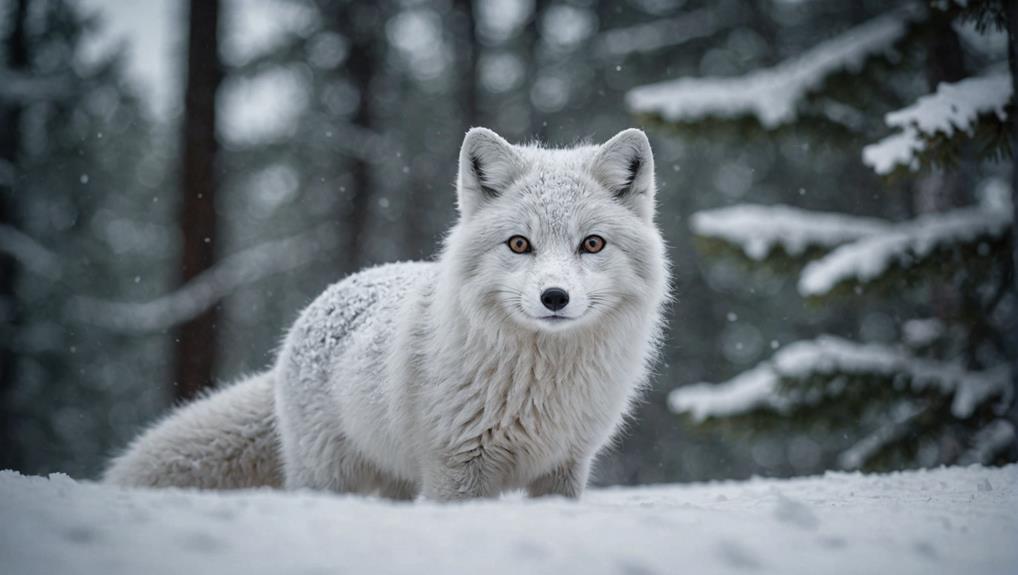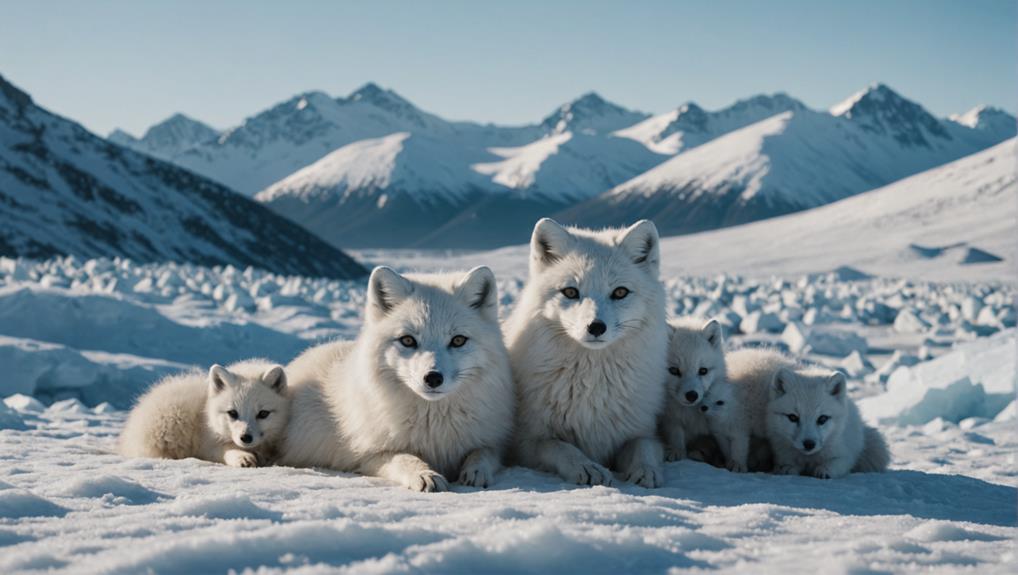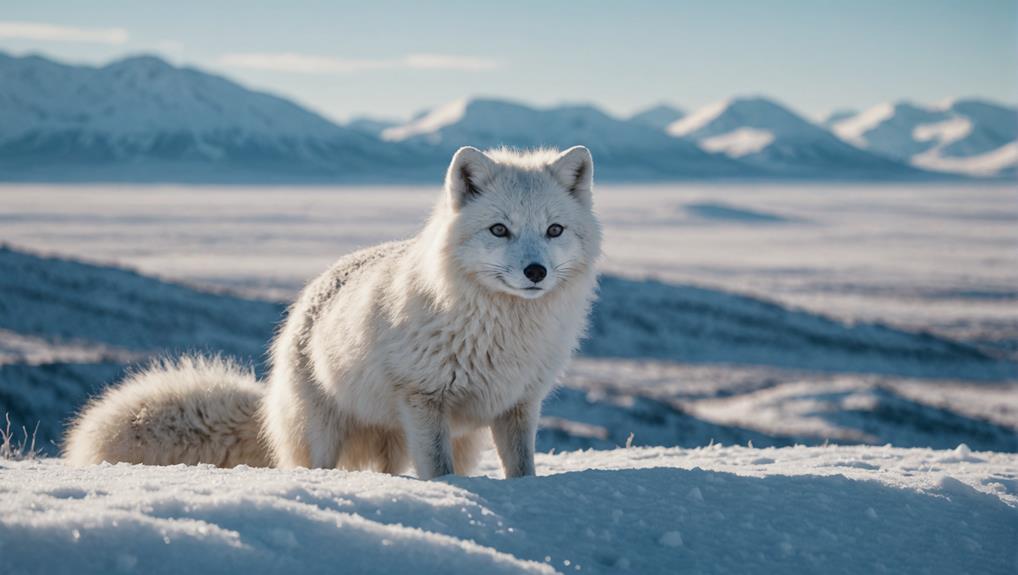Arctic foxes thrive in harsh environments because they're nature's little survival experts! With their thick fur and compact bodies, they keep warm even in the coldest temperatures. Their furry paw pads make it easier to race across snow, while their color-changing coats help them blend in with their surroundings—talk about a furry ninja! They've got clever hunting skills too, diving into the snow for hidden meals. Plus, their teamwork when raising pups boosts their chances of success. These fantastic adaptations make them resilient in the tundra, proving that even the toughest conditions can't hold them back. There's even more cool stuff to discover!
Contents
Arctic Fox Survival Strategies
Arctic foxes have several survival strategies that enable them to thrive in some of the harshest environments on Earth. One of their most impressive features is their thick fur, which keeps them warm and minimizes heat loss. With a compact body shape, they're perfectly built for surviving freezing temperatures, maintaining a cozy core body temperature of around 38°C (100°F).
During the harsh winter months, food availability can be a struggle, but these clever creatures have a few tricks up their furry sleeves. They store fat in the autumn, giving them energy reserves when lemmings and voles are scarce.
Their paws are specially insulated, allowing them to dart across snow and ice with ease, making them quite the efficient hunters.
You'll also notice their seasonal color change, which not only makes them adorable but also helps with camouflage. Imagine sneaking around in a snowy white coat—perfect for avoiding predators while hunting!
Their highly developed sense of smell helps them locate prey even under thick layers of snow, showcasing their impressive hunting efficiency. Arctic foxes truly embody the art of survival in extreme conditions!
Insulation Against the Cold
Survival in the frigid Arctic environment hinges on the exceptional insulation provided by the Arctic fox's double-layered fur coat. This remarkable fur coat isn't just for show; it helps the fox maintain a cozy core body temperature of around 38°C (100°F) even when the temperatures plunge.
Imagine wearing a super warm blanket, but one that's naturally designed to keep you snug!
The thick fur has a dark underside, which helps absorb and retain heat, making it crucial for survival in those icy Arctic regions. Plus, the foxes have a compact body shape, short legs, and small ears that all work together to minimize heat loss. It's like they've got their very own "stay warm" toolkit!
As autumn rolls in, these clever critters bulk up a fat layer, which not only enhances their insulation but also provides energy reserves for the harsh winter ahead.
And don't forget their furry paw pads—these little wonders keep their feet warm while they navigate snowy landscapes.
With all these adaptations, Arctic foxes truly showcase nature's genius in battling the cold!
Seasonal Camouflage Mastery

Nature equips Arctic foxes with an impressive ability to adapt their appearance to the changing seasons. In winter, their thick white coat allows them to blend seamlessly with the snow-covered Arctic tundra. This seasonal camouflage not only keeps them hidden from predators but also enhances their hunting efficiency.
When summer rolls around, their fur color shifts to brown or gray, providing a perfect disguise among the rocks and vegetation.
But there's more to this transformation than just looks! Their winter coat is all about insulation, while the shorter summer coat helps with thermal regulation. You see, Arctic foxes have a clever way of keeping cool when the sun shines. The dark skin beneath their fur absorbs heat, helping them manage the warmer temperatures. It's like they're wearing a stylish outfit that's functional too!
Genetic variations in their coat color help these incredible creatures adapt to diverse environments across the Arctic.
Hunting Techniques in the Tundra
In the frozen expanse of the tundra, the hunting techniques of the Arctic fox are nothing short of remarkable.
These clever creatures have mastered a unique method called "snow-diving." Picture this: they listen intently for the faint movements of lemmings scurrying beneath the snow. With their keen sense of hearing, they can detect prey buried under up to a meter of snow from over 40 meters away! When they spot a potential snack, they leap several feet into the air, using their prehensile movements to pounce right through the snow.
But it doesn't stop there. During the long polar nights, when darkness reigns for up to six months, Arctic foxes remain patient and persistent.
They adapt their hunting strategies, taking advantage of every opportunity, even scavenging from polar bear kills if needed. This opportunistic behavior ensures they make the most of available food resources in such a harsh environment.
Reproductive Success in Extreme Conditions

Navigating the challenges of extreme environments, Arctic foxes exhibit remarkable reproductive strategies that enhance their chances of success. These clever little creatures form monogamous, long-term pair bonds, ensuring that both parents share the care of their adorable kits.
During the approximately 52-day gestation period, they dig dens in safe spots like eskers, giving their young a cozy and secure home.
Litter sizes can range from 5 to 8 kits, but sometimes they can surprise you with as many as 15! This increase in numbers boosts the chances of survival, especially when food resources like lemmings become scarce.
Timing is everything, so Arctic foxes cleverly plan their breeding to coincide with food availability, ensuring the little ones have enough to eat.
Both parents pitch in, hunting and bringing home food to nourish their growing pups. It's a team effort that highlights the importance of care and cooperation in such harsh environments.
Final Thoughts
So, there you have it! Arctic foxes are like the ultimate survivalists of the animal kingdom. With their cozy fur, clever camouflage, and smart hunting skills, they make the harsh tundra their home sweet home. Plus, their ability to thrive in extreme conditions is downright inspiring. It's a reminder that even in the toughest environments, there's always a way to adapt and flourish. Next time you think of winter, imagine these little furballs mastering the chill!














